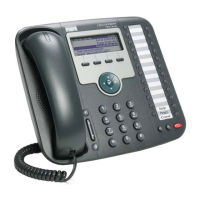5-25
Cisco Unified IP Phone 7931G Administration Guide for Cisco Unified Communications Manager 8.0 (SCCP and SIP)
OL-20798-01
Chapter 5 Configuring Features, Templates, Services, and Users
Configuring Model-Specific Features
• Rollover Within Same DN—Conferences and call transfers are completed using the same directory
number (on different lines and in different partitions). For example, consider a phone that has
directory number 1506 assigned to both Line 6 and 7. The user has an active call on Line 6 and
decides to transfer the call. When the user presses the Transfer button, the call on Line 6 is placed
on hold and a new call initiates on Line 7 to complete the transfer.
• Rollover Across Different DNs—Conferences and call transfers are completed using a different
directory number and line than the original call. For example, consider a phone that has directory
number 1507 assigned to Line 8 and 1508 assigned to Line 9. The user has an active call on Line 8
and decides to transfer the call. When the user presses the Transfer button, the call on Line 8 is
placed on hold, and a new call initiates on Line 9 to complete the transfer.
For related configuration information, see the Cisco Unified Communications Manager Administration
Guide, Cisco Unified IP Phone Configuration.
Assigning the Same Directory Number to Multiple Lines
Although the Cisco Unified IP Phone 7931G does not support multiple calls per line, you can assign the
same directory number to multiple lines. To do so, you must create multiple partitions (at least as many
as the number of lines to share the directory number) and then add the directory number to each partition.
To users, this configuration appears as if they have the same directory number configured on multiple
lines. However, Cisco Unified Communications Manager considers each directory number to be unique
because they are in different partitions.
Note These directory numbers must reside in different partitions and therefore do not truly behave like the
same directory number.
For information about configuring partitions, see the Cisco Unified Communications Manager
Administration Guide, Partition Configuration.
Supporting Barge and Directed Transfer
Some users may not realize that having the same directory number on different lines is not the same as
having multiple calls per line. You should explain that the phone is configured differently and does not
provide the same feature set.
For example, these call features can be achieved on a single line that supports multiple calls:
• Barge and cBarge (Shared lines feature)
• Directed Transfer (Transfer feature)
Because the Cisco Unified IP Phone 7931G does not support multiple calls on a single line, users cannot
use these features on the Cisco Unified IP Phone 7931G, and the end-user documentation does not
include information about them. In some cases, the softkeys for these features may appear on the phone
display even if they are not functional. If a user attempts to use the feature, the phone status displays as
“Error Pass Limit.”
However, if you require these features, you can set the phone to an atypical configuration to support
them (see Supporting CTI Applications, page 5-26).

